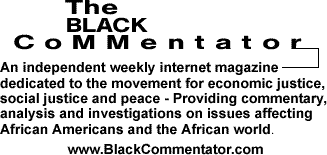
| |
|
Prison-Based Gerrymandering
The Invisible Woman
By Sharon Kyle, JD
BlackCommentator.com Editorial Board
When, Michelle Alexander, author of The New Jim Crow: Mass Incarceration in the Age of Colorblindness, spoke at a gathering in my community, I asked her to give the audience her condensed version of the prison-based gerrymandering phenomenon.
Characterizing it as a modern-day 3/5ths Compromise, Alexander explained that in most states, census residence rules require that incarcerated people be counted at their place of incarceration as opposed to their home address.
She went on to explain that the overwhelming majority of incarcerated people in the United States hail from the major metropolitan centers of this country, while the prisons are typically built in non-urban or rural areas. This counting practice results in a shift in population from urban center to rural community, thereby increasing the political clout of rural communities while decreasing the political clout of urban communities. And, all the while, the incarcerated, almost without exception, cannot vote.
In addressing the census residence rule and specifically prison-based gerrymandering, the NAACP Legal Defense Fund reports:
Over the last several decades, the percentage of Americans incarcerated in prisons has increased four-fold. Incarcerated persons are often held in areas that are geographically and demographically far removed from their home communities. For instance, although non-metropolitan counties contain only 20% of the national population, they host 60% of new prisons.
In addition, because Latinos and African Americans are incarcerated at three to seven times the rate of Whites, where incarcerated people are counted has tremendous implications for how African-American and Latino populations are reflected in the census, and, consequently, how these communities are impacted through redistricting.
Political districts are based on population size. The number of people in a geographical region determines the number of Congressional, state and local representatives. When prison-based gerrymandering is employed, the re-drawing of district boundaries to align with census figures results in large portions of what would have been urban population being reapportioned to rural counties.
Because of this practice, urban communities, particularly urban communities of color, stand to lose the most. Census figures help determine where government money will go to fund hospitals, school services, public housing, social services, food stamps and other programs. The census figures are also used to determine how many seats each state has in the U.S. House of Representatives. Prison-based gerrymandering may result in the loss of both federal dollars and political representation for districts that are already struggling.
This is not only a problem for
The potential negative fallout of this practice is not limited to communities of color. This could have far-reaching political consequences, with Democrats more at risk for getting the short end of the stick. Consider the national impact if Florida, for example counts its growing inmate population in the sparsely populated North Florida counties, where prisons have cropped up like mushrooms over the past decade.
The Prison Policy Initiative reports that
There are multiple factors that explain the explosion
of the prison industrial complex but one factor that is rarely addressed
is the political incentive to drive criminal justice policy toward mass
incarceration for purposes of shifting disenfranchised urban populations
to rural communities. As former
BlackCommentator.com Editorial Board Member and Columnist Sharon Kyle, JD, is the Co-Founder and Publisher of the LA Progressive an online social justice magazine. With her husband Dick, she publishes several other print and online newsletters on political and social justice issues. In addition to her work with the LA Progressive, Ms. Kyle holds a Juris Doctorate, is an adjunct professor at Peoples College of Law in Los Angeles, and sits on the board of the ACLU Pasadena/Foothills Chapter and the Progressive Caucus of the California Democratic Party. Click here to contact the LA Progressive and Ms. Kyle.